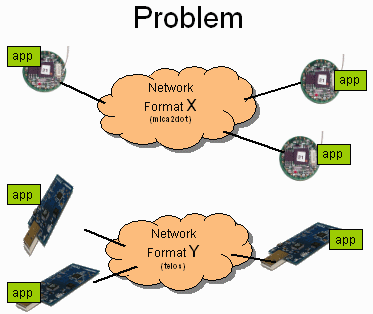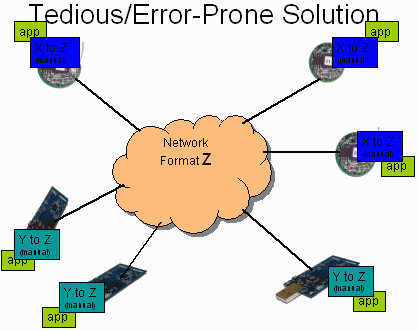 Network Types: Language Support for Messaging in the Heterogeneous Networks
Network Types: Language Support for Messaging in the Heterogeneous Networks
Last updated 16 December 2004
 Network Types: Language Support for Messaging in the Heterogeneous Networks
Network Types: Language Support for Messaging in the Heterogeneous Networks
Last updated 16 December 2004 |
|
Development of network communication in a homogeneous sensor network
environment is straightforward as the nodes can share message layouts
simply by letting the compiler lay out messages in an arbitrary
fashion and using the same executable code on all nodes. But in a
heterogeneous network environment, this simple approach does not work,
as different processors may have different representations or
alignment requirements for basic types: |

|

| One approach to solve this problem is to manually insert marshalling/unmarshalling routines to convert values between network and host representations in each protocol layer. A TinyOS component can call these functions just after receiving from, and just before sending the packets. However, doing so has a few disadvantages. First, the code may not be portable as C provides few guarantees as to data structure layout. This portability problem can be avoided by using only arrays of characters addressed via constant offsets, but this makes code unreadable and hard to maintain. Second, adding the manual conversion functions is a tedious and error-prone process |
|
Network types, our extension to nesC for platform-independent
networking, address the issue of portability, heterogeneity, and
maintenability. Using network types the programmer defines a simple
data structure using syntax very similar to
existing C type declarations, which matches the packet layout, and just
accesses it like a regular C type. The compiler ensures that this type has
the same representation on all platforms and generates any necessary
conversion code.
Network types have no alignment restrictions, network structures contain no padding, and the network base types use a 2's complement, little-endian representation. Thus their representation is platform-independent, and any arbitrary section of memory can be accessed via a network type. The endianness of the base types is little-endian for two reasons: all our current platforms are little-endian, and TinyOS does not yet need to support arbitrary existing protocols. Future versions will also include big-endian base types. |

|
nesC 1.1.3, which includes Network Types, is available from nesC's SourceForge project page.
User documentation for network types is available in the doc/network-types.txt file, reproduced here.
If you wish to use network types to support heterogeneous micaz and telos networks in TinyOS, please follow these instructions:
INSTALL file.
tinyos-1.x/tos/platform/micaz/AM.h
tinyos-1.x/tos/platform/telos/AM.h
tinyos-1.x/tos/platform/micaz/FramerM.nc
tinyos-1.x/tos/platform/micaz/NoCRCPacket.nc
AM.h in tinyos-1.x/tos/lib/CC2420Radio
patch -p0 <tools.patches
patch -p0 <tos.patches
make clean;make in tinyos-1.x/tools/java/net/tinyos
CntToRfm,
CntToLedsAndRfm, RfmToLeds,
OscilloscopeRF and Surge applications can
communicate between micaz and telos. Additionally,
Surge is modified so that it can run on telos (you must
compile with make SENSORBOARD=telos, however). The patch also
changes basic networking (GenericComm), simple flooding
(tos/lib/Brodacast) and routing
(tos/lib/MintRoute) to use network types.
Changing other applications and libraries to use network types is
straightforward: in all types used to describe message formats, change
struct to nw_struct, uint8_t to
nw_uint8_t, int16_t to nw_int16_t,
etc. For example, the original IntMsg.h used by
CntToRfm, CntToLedsAndRfm and
RfmToLeds was changed as follows:
Before the changes:
typedef struct IntMsg {
uint8_t src;
uint16_t val;
} IntMsg;
| After the changes:
typedef nw_struct IntMsg {
nw_uint8_t src;
nw_uint16_t val;
} IntMsg;
|